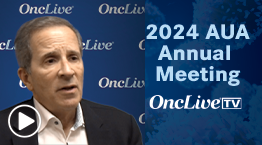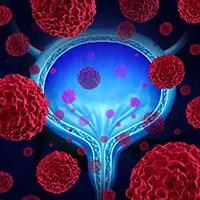Practice-Changing Trials Expand Armamentarium and Improve Guidance in Advanced Breast Cancers
Several landmark trials have led to FDA approval milestones across all breast cancer subtypes in the past 5 years, each continuing to change the navigation of treatment approaches in clinical practice.
Foluso O. (Bisi) Ademuyiwa, MD, MPH, MSCI

Several landmark trials have led to FDA approval milestones across all breast cancer subtypes in the past 5 years, each continuing to change the navigation of treatment approaches in clinical practice, according to Foluso O. (Bisi) Ademuyiwa, MD, MPH, MSCI.
“All of these new approvals are [also] leading to patients with advanced breast cancer living longer and doing better,” Ademuyiwa said in an interview with OncLive® following a State of the Science Summit™ on breast cancer she co-chaired.
The phase 3 KEYNOTE-522 trial (NCT03036488) was the first prospective study to show improved event-free survival (EFS) with pembrolizumab (Keytruda) plus neoadjuvant chemotherapy in high-risk, early-stage triple-negative breast cancer (TNBC), and established pembrolizumab as the first FDA approved immunotherapy for this indication in July 2021.1
In HER2-low disease, practice-changing results were presented in the pivotal phase 3 DESTINY-Breast04 study (NCT03734029) with fam-trastuzumab deruxtecan-nxki (Enhertu; T-DXd). Results from this trial showed consistent survival benefit with T-DXd in patients regardless of HER2 status, supporting the approval of T-DXd in August 2022 as the first regimen for patients with HER2-low breast cancer.2
Ademuyiwa also emphasized how the FDA approval of elacestrant (Orserdu) for postmenopausal patients with estrogen receptor (ER)-positive, HER2-negative, ESR1-mutated advanced or metastatic breast cancer expanded options and bolstered the development of oral selective ER degraders (SERDs).3
Meanwhile, topline data from the phase 3 NATALEE trial (NCT03701334) of adjuvant ribociclib (Kisqali) in ER-positive, HER2-negative breast cancer have been reported as positive in a recent press release and will be submitted to the FDA for approval.4 With abemaciclib (Verzenio) as the only CDK4/6 inhibitor approved in this space, ribociclib’s potential approval could help clarify the role of CDK4/6 inhibitors in this space, Ademuyiwa said.
In the interview, Ademuyiwa expanded on the effect of key research on the treatment paradigm in breast cancer as discussed by herself and her colleagues, including influential trials in early-stage and advanced TNBC. Ademuyiwa, who is an associate professor of medicine in the Division of Oncology, in the Section of Breast Oncology at the Washington University School of Medicine, St. Louis, Missouri, also discussed the future role of oral SERDs in HR-positive breast cancer, emerging research on antibody-drug conjugates (ADCs) in HER2-positive disease, and changing guidance on the use of CDK4/6 inhibitors for HR-positive breast cancer.
OncLive: How have the phase 3 KEYNOTE-522 and DESTINY-Breast04 trials changed or reinforced current practices in TNBC?
Ademuyiwa: There are 2 studies that have really changed the landscape of how we treat patients with TNBC. One is the KEYNOTE-522 trial, [which] randomized women with early-stage TNBC to receive pembrolizumab plus chemotherapy or chemotherapy alone. We saw that patients who got chemotherapy with pembrolizumab had a much higher pathological complete response [pCR] rate and better 3-year EFS. [Data were presented] from that study [at the 2022 ASCO Annual Meeting].
If you look specifically at the rate of distant recurrences, patients that had extensive residual disease, [which is] ultimately fatal, [and were] RCB3 or RCB2 still had a large magnitude of benefit from receiving pembrolizumab even though they had a [poorer] outcome than patients who had a pCR. The take-home message from this [study] is that patients with stage II/III TNBC should be offered neoadjuvant chemotherapy plus pembrolizumab. Pembrolizumab should be continued for 1 year even if patients don’t achieve a pCR, because these are the patients that really need [the treatment].
The second clinical trial that has changed practice for patients with TNBC, specifically those who have HER2-low disease, is the DESTINY-Breast04 study. This was a study in patients who had HER2-low disease [that was] hormone receptor [HR] positive or HR negative. All [patients] had to have been treated with at least 1 line of chemotherapy in the advanced setting. Patients were randomized to receive T-DXd, vs a treatment of physician’s choice. We saw that patients who got T-DXd had a much better progression-free survival [PFS] and lived much longer than those patients who got a treatment of physician’s choice.
Patients [with] TNBC accounted for just about 10% of the entire clinical trial population. However, those patients still similarly benefited [from T-DXd] compared with patients who had HR-positive disease. The take-home message from this study is that patients who have HER2-low disease [that is] HR positive or HR negative should be considered for T-DXd if they are eligible.
Looking at the presentation given by Cynthia X. Ma, MD, PhD, of Washington University School of Medicine, could you expand on the evolution of oral SERDs in HR-positive breast cancer, as well as their future development in this space?
[Elacestrant represents] an exciting new approval for patients with HR-positive breast cancer. The [EMERALD] trial [NCT03778931] looked at patients who already had first-line treatment with a CDK4/6 inhibitor plus endocrine therapy and had progressed on that [therapy]. [Patients who had] ESR1-mutant [tumors] seem to have benefitted [most] from elacestrant, so it’s now approved [in that population]. We are now actively looking for patients who have ESR1 mutations who have had 1 line of endocrine therapy plus a CDK4/6 inhibitor.
Typically, you will not find [ESR1 mutations] when patients initially present with metastatic HR-positive breast cancer. If a patient progresses after receiving first-line endocrine therapy, we encourage [them] to get tested for this mutation, because this is something that happens later [in] the course of the disease.
Hopefully this [approval] has expanded the treatment armamentarium for these patients.
What is the optimal sequencing of current CDK4/6 inhibitors within HR-positive, HER2-negative breast cancer based on the updates presented by Katherine Clifton, MD, of Washington University School of Medicine?
CDK4/6 inhibitors are now the standard of care for patients with HR-positive, HER2-negative breast cancer in the first-line setting. There are 3 CDK4/6 inhibitors [in this space]: palbociclib [Ibrance], ribociclib and abemaciclib. They are a little bit different. We’ve seen that ribociclib has now shown an overall survival benefit [in] recent clinical trials, whereas the other [agents] have yet to show that. [Accordingly], practice has changed.
Many physicians are now recommending ribociclib in the first-line setting for patients with advanced breast cancer because of the survival benefit that we’ve seen. The toxicity profile is [also] a bit different among the 3 CDK4/6 inhibitors. Abemaciclib has more gastrointestinal toxicities, whereas palbociclib and ribociclib have more cytopenia. With ribociclib, we can [also] see EKG changes, although these are rare. This might be another way of selecting a CDK4/6 inhibitor for patients.
In the adjuvant setting, abemaciclib is the only [CDK4/6 inhibitor] that has shown clinical benefit...in combination with adjuvant endocrine therapy. We have yet to see the data on ribociclib [from the NATALEE trial]. Although we’ve seen the initial press release that [the trial was] positive, we don’t know what the specific numbers are. [Lastly], the data on palbociclib were negative in the adjuvant setting.
How have findings from the phase 2 MAINTAIN (NCT02632045) and PACE (NCT03147287) trials influenced your practice in the metastatic setting?
The phase 2 MAINTAIN study [was] very interesting. It showed that patients who have progressed on palbociclib may benefit from continuing or switching endocrine therapy and switching the CDK4/6 inhibitor to ribociclib. This can potentially be used for select patients, although it’s a small, phase 2 study, and we need to see more data.
The PACE study evaluated palbociclib following palbociclib. [The trial] was negative, so that is something we should not be recommending for patients. Have I recommended switching to ribociclib after palbociclib [in my practice]? Not yet. Will I do it in the future? Possibly, but I think we need to see more data [first]. [Still, the current] data [are] very encouraging and interesting.
In light of exciting research in HER2-positive breast cancer, which were presented by Nusayba A. Bagegni, MD, of Washington University School of Medicine, how might emerging ADCs continue to improve HER2-positive breast cancer treatment?
There’s been an explosion of new agents in HER2-positive disease, particularly ADCs in development. We look forward to seeing how [they] will match or compete against the current standard of care, which has really changed the survival of patients with advanced HER2-positive breast cancer. [There are some] exciting new data with new ADCs coming out.
Could you summarize the key take-home messages from this meeting?
Selecting patients with TNBC for pembrolizumab with chemotherapy leads to higher rates of pCR and improves survival for these patients. For patients with HER2-low disease, we should now be checking for HER2-low status and considering these patients for T-DXd. [Patients on] T-DXd [are at] risk of interstitial lung disease [ILD], so we should be actively checking for that [by] doing chest CT [scans] no later than every 9 weeks. [We need] to look for [ILD] because it could be asymptomatic.
In terms of HER2-positive breast cancer, [we should] now use T-DXd in the second line for patients who are eligible and appropriate. [We should also be] looking for ESR1 mutations in patients who progress following initial endocrine therapy with CDK4/6 inhibition in the first-line setting.
In the adjuvant, early-stage setting, [we should] use the CDK4/6 inhibitor abemaciclib for appropriate patients. [Finally], adjuvant olaparib [(Lynparza) should be used] for appropriate patients with BRCA1/2 mutations.
Disclosure: Dr. Ademuyiwa reports serving in a consultory or advisory role for Teladoc Health, Pfizer, AstraZeneca, Biotheranostics, Gilead, Cardinal Health; she received research funding from Pfizer, Astellas, and RNA Diagnostics.
References
- FDA approves pembrolizumab for high-risk early-stage triple-negative breast cancer. News release. FDA. July 27, 2021. Accessed April 10, 2023. https://www.fda.gov/drugs/resources-information-approved-drugs/
- FDA approves first targeted therapy for HER2-low breast cancer. News release. FDA. August 5, 2022. Accessed April 10, 2023. https://www.fda.gov/news-events/press-announcements/FDA approves elacestrant for ER-positive, HER2-negative, ESR1-mutated advanced or metastatic breast cancer. FDA. January 27, 2023. Accessed April 10, 2023. https://www.fda.gov/drugs/resources-information-approved-drugs/Novartis Kisqali phase III NATALEE trial meets primary endpoint at interim analysis demonstrating clinically meaningful benefit in broad population of patients with early breast cancer. News release. Novartis. March 27, 2023. Accessed April 10, 2023. https://www.novartis.com/news/media-releases/



